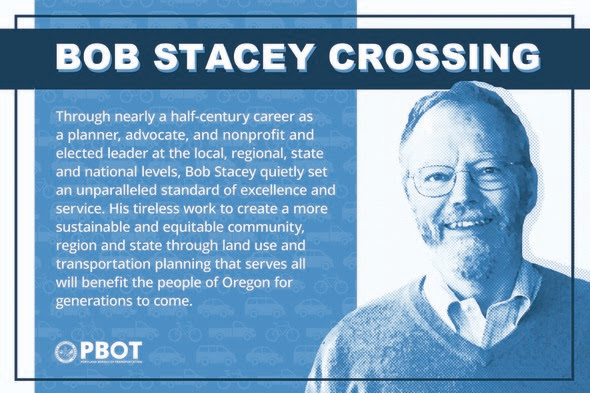New Bridge Honors Metro Councilor
Portland bridge is named for visionary planner Bob Stacey ’72.
He’s been an activist, an advocate, a planner, a policy wonk, and a public servant. For 50 years, Metro Councilor Bob Stacey ’72 shaped the Portland area through a visionary commitment to sustainable growth. Now he holds the unusual distinction of having a bridge named in his honor.
Chris Warner, director of the Portland Bureau of Transportation, announced today that PBOT’s new bike and pedestrian bridge, located near the intersection where the MAX Orange Line crosses SE Milwaukie Avenue, will henceforth be known as the Bob Stacey Crossing, honoring a lifetime of leadership in sustainability and transportation planning.
“It’s an honor to name Portland’s newest bike and pedestrian bridge for Councilor Bob Stacey,” Warner said. “Bob has always understood that how we get from place to place is critical to building a more sustainable, safer and more equitable community. Thanks to his commitment to public service and his belief that there is always a better, fairer way to do things, Bob has achieved what I think all of us in public life strive for: to create a lasting legacy of helping our neighbors and improving our community.”
The announcement, which took place at a virtual meeting of the Metro Council, caught Bob by surprise. “I’m flabbergasted,” he said, blinking back tears. “Thank you for this wonderful honor.”
Progressive leaders lined up to praise Bob and his contributions to Portland.
“No one has been more deeply involved in shaping our quest for livability than Bob Stacey. For over 40 years, he has been involved with nonprofit advocacy and in the city, state, regional government and TriMet," said U.S. Rep. Earl Blumenauer. "More recently, as an elected official at Metro, he continues to be a powerful voice of reason, inclusion and principle. The ideal role model for citizens who want to protect our future while managing the present."
“It’s been a privilege to have known Bob Stacey going back 3 decades," said Portland Transportation Commissioner Jo Ann Hardesty. "Since we first got to know each other, it’s been clear just how committed he is to good land use and transportation planning. I can’t think of a more appropriate name for this pedestrian bridge than calling it Bob Stacey Crossing to honor his legacy.”
Bob grew up in east Portland and came to Reed during the tumultuous late sixties. He majored in political science and wrote his senior thesis on the Bonneville Power Administration’s hydrothermal program.
After earning his degree at Reed, he went on to law school at the University of Oregon and soon became a stellar force in local politics. He was a partner at Ball Janik LLP and has served as a senior policy advisor to Gov. Barbara Roberts, a chief of staff to Congressman Earl Blumenauer, and executive director for policy and planning at TriMet. He has also served as Portland’s planning director and as the executive director of 1000 Friends of Oregon, the nonprofit founded in 1974 by Henry Richmond and Governor Tom McCall to support their vision of Senate Bill 100 and our state’s iconic land use planning system. In this same McCall spirit, on behalf of 1000 Friends, he sued Metro to tighten restrictions on the region’s urban growth boundary.
Bob was elected to the Metro Council in 2012, where he has pursued his passion for affordable housing, the efficient use of land and the protection of farms and forests, and investing in a robust bicycle, pedestrian, and transit network. He serves on the Metro Policy Advisory Committee, the region’s roundtable on transportation, and liaises to Metro’s Transit Oriented Development steering committee and on the board of the Columbia Corridor Association. He worked directly with staff, community partners, and local leaders to plan the region’s latest high-capacity transit lines—the Division Transit Project and Southwest Corridor light rail.
He has been a staunch advocate for more housing density and prioritizing affordable housing near MAX stations. His most recent work is to help push the Portland metro region to adopt congestion pricing, speaking the truth about induced demand on city highways, lessons he has learned from watching cities like Atlanta, Houston, and Los Angeles make poor choices.
He and his wife Adrienne share their Southeast Portland home with a daughter, son-in-law, and two grandsons.
About the Bob Stacey Crossing
The Bob Stacey Crossing, which opened in November, 2020, takes travelers from SE 14th Avenue north of the tracks to SE 13th Place at Gideon Street, near the Clinton St / SE 12th Ave MAX Station, on the south side. The bridge provides a north-south connection above busy MAX and Union Pacific freight rail lines.
The $15 million bridge was deferred during the development of the Portland-Milwaukie Light Rail Project (which built the MAX Orange Line) in 2010. But with the strong support of Councilor Stacey, PBOT, federal partners, and community members, TriMet successfully secured approval from the Federal Transit Administration (FTA) to construct the bridge using some of the remaining funds from the MAX project.
The bridge includes a variety of new features intended to make it convenient and comfortable for people using bicycles or mobility devices. The elevators are large enough to accommodate bicycles with a trailer or child’s tag-along attachment. The pass-through elevators allow people to enter on one side and exit on the other side, avoiding the need to go backwards or turn around, with a mobility device or a large bicycle. More details are available in a PBOT news release from opening day.
The Bob Stacey Crossing is owned, operated and maintained by PBOT.
Many thanks to PBOT public information officer and media strategist Dylan Rivera ’95 for help with this post.
Tags: Alumni, Awards & Achievements, Climate, Sustainability, Environmental, Service
